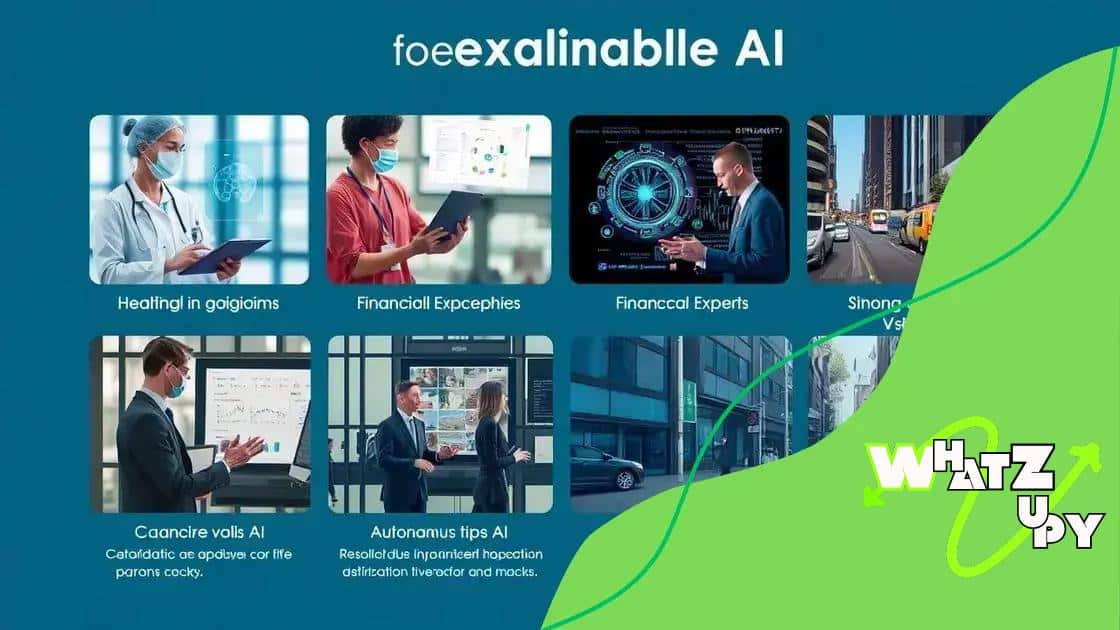Explainable AI: Building trust in automated decisions

Explainable AI enhances transparency in automated decision-making, building user trust by providing clear insights into how AI systems reach their conclusions and improving decision-making processes across various sectors.
Explainable AI fosters trust by providing transparent insights into automated decisions. Have you ever wondered how machines make choices? This article dives into its significance and why it matters.
Understanding explainable AI
Understanding explainable AI is vital in today’s data-driven world. It helps us learn how machines make decisions that impact our lives. But why does this matter?
When we talk about explainable AI, we focus on clarity. Machines often operate in ways that are hard to understand. Hence, it is crucial to break down these processes. Explainable AI provides transparency, which leads to trust in automated systems.
Key Concepts of Explainable AI
At its core, explainable AI aims to offer insights into how AI systems reach conclusions. It answers fundamental questions:
- What data is being used?
- How are decisions made?
- What factors affect outcomes?
This clarity is crucial for developers and users alike. For developers, it ensures the AI systems are fair and unbiased. For users, it means having confidence in automated decisions.
Importance of Transparency
Transparency fosters trust. If users understand how a system operates, they are more likely to embrace it. People want assurance that decision-making processes are reliable. When they see the reasoning behind a decision, such as a loan approval or medical diagnosis, their confidence in the AI increases.
Additionally, misunderstandings can lead to frustration. Without clear explanations, users might question the decisions made by AI. This can create resistance toward adopting AI solutions.
Challenges in Explainable AI
Despite its importance, explainable AI faces challenges. Many sophisticated models, like deep learning, operate as “black boxes.” Here’s what we need to overcome:
- Complexity of algorithms
- Balancing performance and interpretability
- Avoiding oversimplification
To address these hurdles, researchers are actively working on techniques to clarify these complex models while maintaining their effectiveness. Through collaboration, we can enhance how we understand AI.
Ultimately, as technology evolves, so does the need for clear, comprehensible insights into its workings. Understanding explainable AI is the first step toward better interaction with these systems.
Key benefits of explainable AI
Exploring the key benefits of explainable AI reveals its significance in modern technology. As machine learning systems grow more complex, understanding their workings becomes essential.
One of the primary advantages of explainable AI is its ability to enhance trust. When users grasp how decisions are made, they are more likely to rely on these systems. This transparency is critical in areas like finance and healthcare, where decisions can have significant impacts.
Enhanced Decision-Making
Another benefit is improved decision-making. By providing clear insights into the factors influencing outcomes, explainable AI allows human users to make informed choices. They can identify potential biases that may affect results.
- Detecting bias in data
- Ensuring fairness in algorithms
- Making adjustments based on feedback
This iterative feedback process promotes a better understanding and refinement of AI systems. Additionally, users can actively learn from these systems, fostering a culture of continuous improvement.
Compliance and Accountability
Explainable AI also plays a vital role in ensuring compliance with regulations. Many industries have strict guidelines around data usage and decision-making processes. By making AI systems more transparent, organizations can demonstrate adherence to these regulations.
Moreover, having accountable AI systems facilitates easier auditing. Companies can trace back decisions to their underlying logic, effectively addressing concerns when issues arise.
As companies grow aware of the benefits of explainable AI, integration into business practices is becoming more prevalent. It not only boosts user confidence but also fosters innovation within organizations.
Applications of explainable AI in real-world scenarios

The applications of explainable AI in real-world scenarios showcase its transformative potential across various industries. Understanding how these systems work in practice highlights their importance.
In healthcare, for example, explainable AI assists doctors in diagnosing diseases. By providing insights into the reasoning behind recommendations, these systems enhance trust between patients and healthcare providers.
Financial Services
Similarly, in the financial sector, explainable AI plays a pivotal role in risk assessment and loan approval processes. Automated systems analyze data and present findings, which helps financial institutions maintain compliance with regulations and eliminate biases.
- Improving credit scoring models
- Enhancing fraud detection capabilities
- Streamlining loan approval processes
This transparency is not just for regulatory reasons; it also builds customer confidence. When clients understand the reasoning behind financial decisions, they feel more secure in their choices.
Autonomous Vehicles
Another fascinating application lies in autonomous vehicles. These AI systems need to explain their decision-making processes to ensure safety. Whether it’s navigating through traffic or responding to unexpected obstacles, the ability to elucidate actions is crucial.
Moreover, as explainable AI continues to evolve, it helps developers improve algorithms. Feedback loops enable teams to refine models based on user experiences and preferences, bridging the gap between technology and human understanding.
In education, explainable AI aids in personalizing learning experiences. By analyzing student data, these systems can provide tailored recommendations, helping students and teachers identify effective study techniques.
As industries adopt explainable AI, its impact becomes increasingly apparent. Each application not only demonstrates potential improvements but also reaffirms the need for transparency in technological advancements.
Challenges faced in implementing explainable AI
Implementing explainable AI presents several challenges, even though its benefits are clear. One significant hurdle is the complexity of many AI models. These models, often described as “black boxes,” can make it tough to provide straightforward explanations for their decisions.
The intricate algorithms used in deep learning or neural networks raise questions about their interpretability. To address this, researchers are developing techniques to make these models more understandable. However, balancing accuracy and interpretability remains a challenge.
Data Quality and Availability
Another critical issue revolves around the quality of data. Poor-quality or biased data can lead to misleading outcomes. When data isn’t representative, the explanations provided by explainable AI may also be flawed. Organizations must invest in collecting high-quality, relevant data to support their AI systems.
- Ensuring data diversity
- Regularly updating datasets
- Conducting thorough data audits
These steps are essential in minimizing bias and improving the reliability of AI-driven decisions.
User Understanding and Trust
Building trust in these systems also poses a challenge. Users need the knowledge to understand explainable AI outputs fully. If users do not grasp the reasoning behind decisions, their faith in the system remains low. Training and education are crucial but require time and resources.
Moreover, different stakeholders may have varying expectations of explainability. While some may seek detailed insights, others may prefer simpler summaries. Striking a balance between these demands can complicate the implementation process.
As organizations strive to integrate explainable AI into their operations, overcoming these challenges becomes essential. Each challenge requires careful consideration and innovative solutions to enhance clarity and trust in AI systems.
The future of explainable AI and trust
The future of explainable AI looks promising as it becomes increasingly integrated into various sectors. As technology evolves, the emphasis on building trust through transparency is paramount.
One major aspect is the ongoing development of more intuitive explanation methods. Researchers are exploring ways to simplify complex AI systems and present their decisions in understandable terms. This trend will likely continue as users demand greater clarity.
Advancements in Technology
As technology advances, machine learning models will become more sophisticated, yet easier to interpret. New techniques are being tested to enhance how AI communicates its reasoning. For example, visual representations of decision-making processes can help users grasp how outcomes are determined.
- Interactive dashboards for real-time insights
- Visual storytelling to convey AI processes
- Personalized explanations tailored to user needs
These innovations will help bridge the gap between AI systems and users, fostering a stronger sense of trust.
Regulatory and Ethical Considerations
The landscape of AI regulation is changing as governments recognize the importance of accountability. Regulations focused on explainable AI will likely emerge to ensure ethical use. These policies can guide companies in creating transparent systems that prioritize user trust.
As organizations comply with such regulations, they will need to invest in developing AI that meets these standards. This shift will likely lead to a more ethical approach to AI development, emphasizing safety and responsibility.
Furthermore, public awareness of AI’s capabilities and limitations will play a critical role in shaping its future. As people become more informed about AI systems, the demand for transparency will grow. Increased awareness can drive companies to prioritize explainable AI solutions in their offerings.
Ultimately, the future of explainable AI lies in its ability to build trust through transparency and ethical practices. By focusing on these areas, organizations can create systems that users not only understand but also embrace.
FAQ – Frequently Asked Questions about Explainable AI
What is explainable AI?
Explainable AI refers to methods and techniques that allow users to understand how AI systems make decisions. It emphasizes transparency and clarity in AI processes.
Why is transparency in AI important?
Transparency builds trust between users and AI systems. When people understand how decisions are made, they are more likely to embrace and rely on these technologies.
What challenges do organizations face when implementing explainable AI?
Organizations often encounter challenges such as the complexity of AI models, data quality issues, and the need for user understanding. Balancing accuracy with interpretability is also a key concern.
How can explainable AI improve decision-making?
Explainable AI provides insights into the reasoning behind decisions, allowing users to detect biases, understand outcomes, and make informed choices based on clear reasoning.





